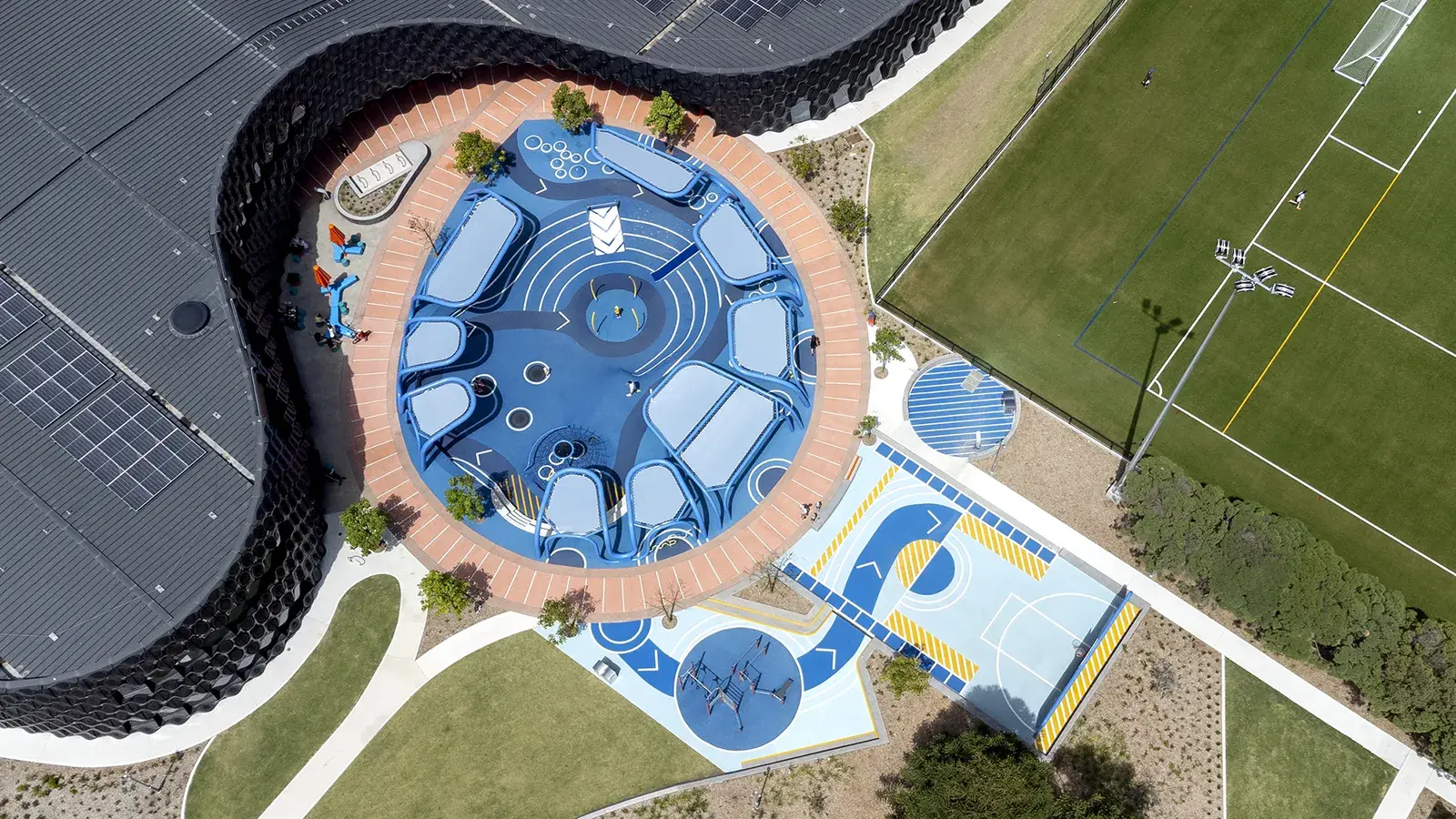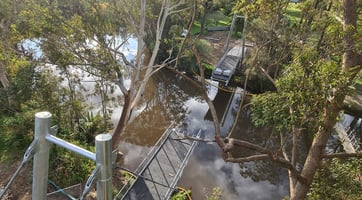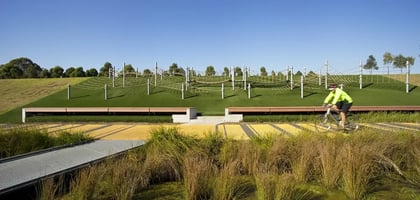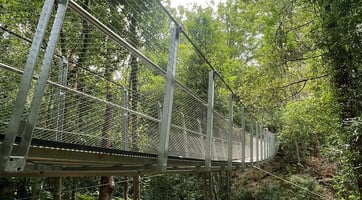A Legacy of Movement: Designing Play & Recreation for Every Generation
“The Olympics has such a high profile, it’s the pinnacle of sport—but, developmentally, everything begins with play.” - Mark Jol.
Welcome to the fifth instalment of our Brisbane 2032 series. In this latest article, we chat with FORGE Creative & Technical Lead, Mark Jol— a passionate advocate for intergenerational play and a creative force behind many award-winning custom Play structures developed in partnership with our clients. Together, we explore the once-in-a-generation opportunity Brisbane’s 2032 Olympic investment presents to foster a legacy of movement, play and public space engagement across South-East Queensland—and some of the key design considerations to help make it happen.

Mark Jol, FORGE Creative and Technical Lead
Mark, the sites are locked in and planning is well underway to deliver world-class venues for the Olympics in Brisbane. But what about the opportunity for 2032 to be used more widely to encourage future generations of health, movement and wellbeing?
Mark Jol: “At the heart of the Olympic movement is movement itself, so 2032 is certainly a great opportunity to get more world-class infrastructure on the ground. It’s more than just elite venues. Imagine new community infrastructure that encourages Queenslanders of all ages and abilities to move, run, jump, climb, explore and generally be more active. Sporting facilities are clearly part of that, but I think the power of play is often overlooked. The Olympics has such a high profile, it’s the pinnacle of sport—but, developmentally, everything begins with play.”
It’s easy to think of Olympic legacy purely in terms of sport, but as you say, play also has such a big role in those early years.
Mark Jol: “Movement and play are hugely important parts of growing up and the benefits aren’t just physical. Play is also one of the main precursors to organised sport—not so much in following pre-set rules, but more the unstructured interactions and moments where you learn about communicating with others, personal dynamics, problem solving and risk taking, success and disappointment, all those things. When you develop play spaces and structures, what you’re really doing is providing opportunities for children to create their own play, move and interact with each other, and try things they wouldn’t normally do. It’s all helping that development process.”
Left: Mountain Park, Spring Mountain (QLD) | Right: The Ian Potter Children's Wild Play Garden, Centennial Park (NSW)
What are some of the key things you’re considering when you set out to design a new bespoke play structure?
Mark Jol: “First and first foremost, what’s the purpose? Is it a small community pocket park or is it a major regional park where thousands of families are going to visit? Understanding this really dictates how you think about the size and nature of the space and also movement through the structures for the different people who will be there. Peninsula Playground at Southport’s Broadwater Parklands (City of Gold Coast) is a good example of that, it’s a true destination playground with a wide range of play elements and zones that get very, very busy. The design thinking there is quite different to, say, Casuarina Park at Woodbury (Fiteni Properties) in Brisbane’s Bayside which is more of a local community park where you don’t get that same level of foot traffic with queues of waiting at the top of the slides. As a designer you’re constantly thinking about the scale, the purpose and how you design to that.”
Left: Peninsula Playground at Broadwater Parklands (QLD) | Right: Casuarina Park at Woodbury (QLD)
“The second big consideration is, what’s the theme or vision? This provides a real creative focus. Typically our projects already have some kind of theme, but not always. We’ve recently been working on a project in regional Queensland where, initially, the client didn’t really have a set theme, so we worked with some ideas from the local community and created one from those. As designers, you want play structures to be fit for purpose and the theme is central to that—it should speak to the community and also to the space itself.”
“Of course, the other thing is budget. Obviously when you have an unlimited budget you can do unlimited things, but if you have a smaller budget it’s a different type of design challenge. There’s often tension balancing the project budget versus community expectations too. You need to be careful as you can easily consume many, many work hours trying to realise something that simply isn’t achievable, not properly anyway.”

Render and Reality - Denman Village Playground, Denman Prospect (ACT)
How do you avoid situations like that?
Mark Jol: “Early communication. For example, if you’re looking for a bespoke play product, it’s a great idea to contact a company like FORGE and ask to see some examples of structures with similar budgets. We do that almost on a daily basis. It’s also where the value of a Design Scoping Package, or DSP, can really come into its own. You have that starting point of an idea and then work collectively to ensure it can actually be done.”
Sir Joseph Banks Park, Botany (NSW)
“For instance, the initial vision might be for a soaring 10-metre high play tower that can be seen for miles around—but if you put all your budget into the tower, you may not have enough money for the play elements inside. During the DSP process we might explore what would happen if we took it down to, say, six meters and then use the saved money to pack it full of play moments. The DSP is a perfect way to work through these sorts of decisions. We’ve successfully used it for many bespoke play structures. One that comes to mind is Sir Joseph Banks Park (Bayside Council), a really inclusive and multigenerational play space near Botany Bay in Sydney. We’ve also used the process to refine custom play structures in the ACT and an amazing project in Queensland that featured two big towers connected by a maze. All very successful outcomes with very happy local communities.”

Billubera Park, Yarrabilba (QLD)
On the subject of successful play outcomes, we often talk about the importance of inclusive and intergenerational design. How does that influence your approach?
Mark Jol: “It has a huge influence. Designing for one specific age group—or ‘ability group’ as I prefer to say—is very simple, but it isn’t always the right way to go. For example, if a play area is just for little toddlers, then you design elements that only a toddler can use. Of course, before long that toddler is bigger and much more abled, they’ll naturally want push harder, so if the play area is only suited for that one ability group, there’s a ceiling and it loses much of its appeal.”
“Rather than put a lid on things, you try to remove that lid in the way play structures are designed so they’re versatile spaces where kids of all ability groups have opportunities to go further when they’re ready, to stretch themselves physically and psychologically. That said, it’s also about including those little ‘outs’ in the design, so if a child gets really worried or stuck, they can stop and maybe try again next time. It might be as simple as adding a little ladder next to the big slide or the scary wobble bridge. Kids don’t actually realise how much they’re developing when they’re using these structures, all they know is two years ago they could only use the lower levels, now they can get all the way to the top!”

Gramercy Boulevard Playground, Point Cook (VIC)
I guess the last thing any client wants is to be stuck with is a one-dimensional play structure where kids are saying ‘okay I’ve done that, I’m bored now.’
Mark Jol: “That’s right, and even the most amazing bespoke play structure is only ever one part of the overall landscape. You might have a big tall slide, but what about versatile adjacent spaces where the older kids can go to kick a football or simply hang out? From that intergenerational point of view, you also need to consider that many parents might have three or four kids they need to watch from a safety perspective. If senior play and junior play areas are too far apart, or hard to see, you suddenly you need two or more parents. Having everything cleverly designed into the same structure or precinct is a big part of the design thinking.”

Blacktown Exercise, Sports and Technology Hub, Rooty Hill (NSW)
Does that also influence the way amenity is incorporated for the caregivers who are watching their kids—things like toilets, seating, space to park a pram, BBQ facilities, even lighting?
Mark Jol: “We’re definitely thinking about these things, again it’s all part of that inclusive approach where everyone feels welcome. That said, it often depends on our level of involvement in the project and if it extends beyond those main structural play elements. Again, communication is super important, it’s why we work closely with the landscape architects, architects and landscape contractors to make sure the job is seamless. The design and location of each element and amenity has to have a purpose. The other thing that makes visits more enjoyable is shade and we certainly help many clients with bespoke shade structures that match their vision.”

Bungarribee Park, Arndell Park (NSW)
If the play experience isn’t comfortable—for the parents and the kids—they’ll be less likely to stay, or come back again.
Mark Jol: “Absolutely, you certainly don’t want to have to run home because your two-year-old needs to go to the toilet—or you do! Great play spaces need amenities that are safe, clean and accessible. Even if the facilities are based on proprietary off-the shelf systems, how can they be located and incorporated thoughtfully with the actual design of the play spaces?”
Left: Bokarina Beach Park, Bokarina (QLD) | Right: Everleigh Amenities, Greenbank (QLD)
We’ve talked about designing play structures that can provide a lasting legacy of movement across Brisbane. Hand in hand with this, of course, is making sure the structures themselves actually last. How do you ensure that?
Mark Jol: “It’s a really good question. Playgrounds tend to cop a real beating from the kids, there’s a lot of wear and tear. Designing the core structure to last for a long time, maybe as much 50 years in some instances, is important. But it’s also about making sure the pieces within it can be easily accessed, maintained or replaced as necessary. The materials themselves must be resilient too, especially in locations around South-East Queensland. For example, if you’re in a bayside area, you might need to consider wind loadings quite differently. We’ve also delivered many structures in coastal locations, such as Bokarina Beach on the Sunshine Coast and Broadwater Parklands at Southport, where corrosion can be a big issue—having the correct paint systems and designing out connections that are going to trap moisture and debris is a critical part of what we do.”
“If you don’t keep these things in mind from the start of the initial idea, you can quickly go down the rabbit hole of designing something you think is amazing, but it’s simply not going to last. If that happens, your legacy is going to be a pretty short one!”
That’s so true, Mark. Any final comments before we finish up?
Mark Jol: “2032 is a unique opportunity—not just today, but for generations to come—and I really hope Play is considered as a part of the wider infrastructure program for the people of Brisbane. After all, there’s every chance some of the children who run, jump, swing, slide and play on these structures will end up being the next Australian Olympians.”
Left: Jingeri Park, Redland Bay (QLD) | Middle and Right: Atherstone Regional Play Space, Melton South (VIC)
Every play structure has an opportunity to spark curiosity, connection and growth. Let’s design something that leaves a lasting legacy for the next generation. Chat to FORGE about how we can shape better places to play.





